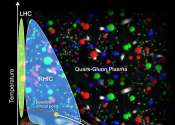Physics professor publishes exact solution to model Big Bang and quark gluon plasma
Unlike in mathematics, it is rare to have exact solutions to physics problems.

Unlike in mathematics, it is rare to have exact solutions to physics problems.
General Physics
Dec 16, 2014
0
0

A new analysis by the STAR collaboration at the Relativistic Heavy Ion Collider (RHIC), a particle collider at the U.S. Department of Energy's (DOE) Brookhaven National Laboratory, provides the first direct evidence of the ...
General Physics
Feb 23, 2024
0
255

Physicists report new evidence that production of an exotic state of matter in collisions of gold nuclei at the Relativistic Heavy Ion Collider (RHIC)—an atom-smasher at the U.S. Department of Energy's (DOE) Brookhaven ...
General Physics
Feb 27, 2023
0
154

(Phys.org)—A panel of experts on the Nuclear Science Advisory Committee (NSAC) has decided to recommend closing the Relativistic Heavy Ion Collider (RHIC) in New York. The move comes after budget cuts for physics research ...

Where does the proton get its spin? This question has puzzled physicists ever since experiments in the 1980s revealed that a proton's constituent quarks—the most fundamental building blocks of atomic nuclei—account for ...
General Physics
Oct 12, 2021
0
158

For a gargantuan nuclear physics experiment that will generate big data at unprecedented rates—called A Large Ion Collider Experiment, or ALICE—the University of Tennessee has worked with the Department of Energy's Oak ...
General Physics
Apr 30, 2020
0
131

New measurements of how particles flow from collisions of different types of particles at the Relativistic Heavy Ion Collider (RHIC) have provided new insights into the origin of the shape of hot specks of matter generated ...
General Physics
Jun 27, 2023
0
83

Scientists hoping to unravel the mystery of proton spin at the Relativistic Heavy Ion Collider (RHIC), a 2.4-mile-circumference particle accelerator at the U.S. Department of Energy’s (DOE) Brookhaven National Laboratory, ...
General Physics
Feb 15, 2011
4
2

Nuclear physicists analyzing data from the PHENIX detector at the Relativistic Heavy Ion Collider (RHIC)—a U.S. Department of Energy (DOE) Office of Science user facility for nuclear physics research at Brookhaven National ...
General Physics
Dec 10, 2018
1
217

Scientists taking advantage of the versatility and new capabilities of the Relativistic Heavy Ion Collider (RHIC), an atom smasher at the U.S. Department of Energy’s Brookhaven National Laboratory, have observed first ...
General Physics
Aug 14, 2012
5
0